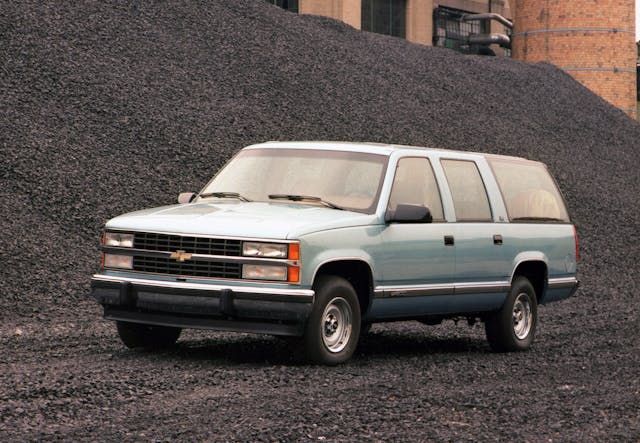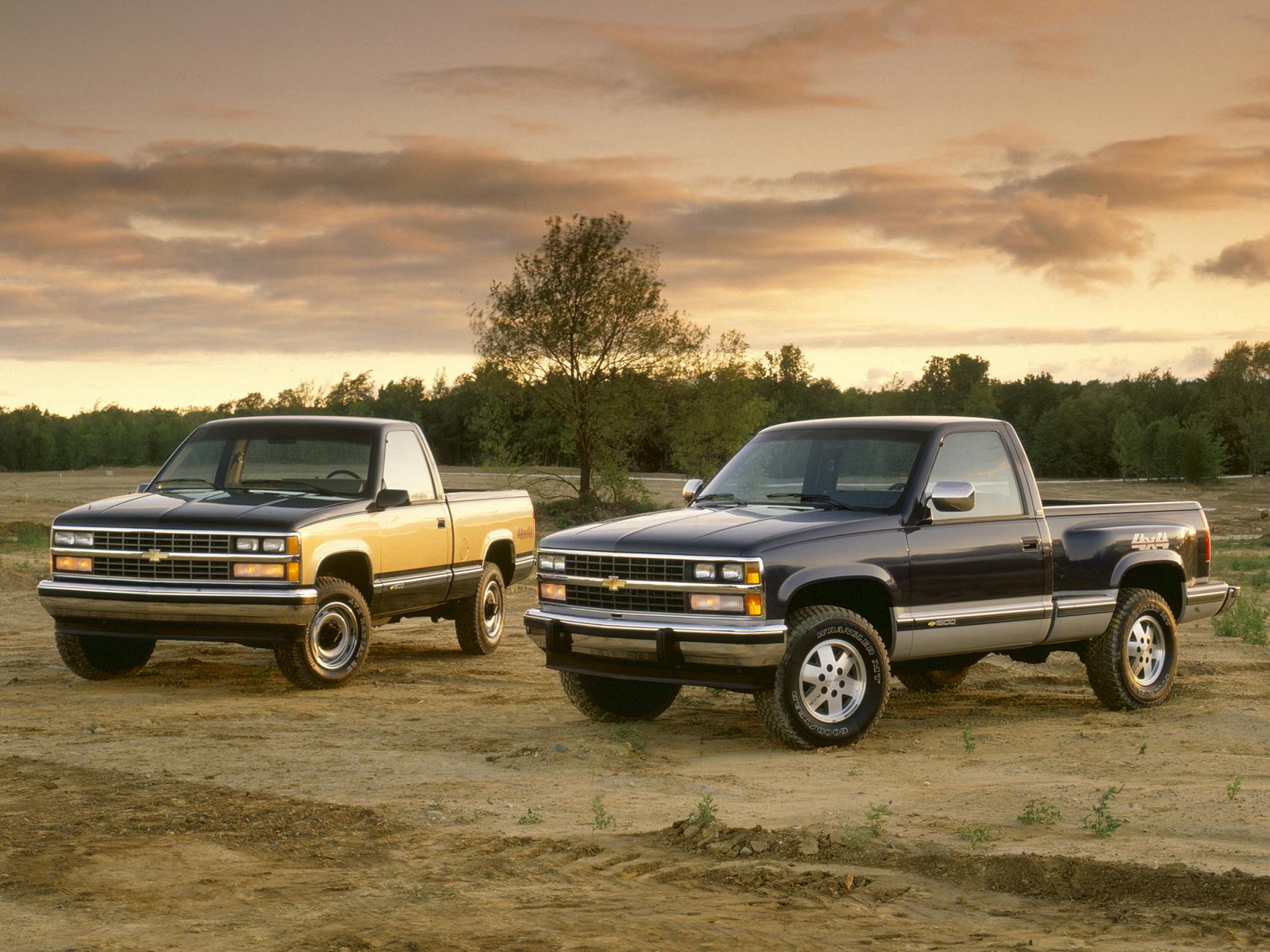Media | Articles
Values for GM’s full-size trucks (1988–2002) are still rock-solid
Like a rock
I’m six years old again. I’m in my grandma Squeak’s living room, playing with Hot Wheels on drab brown carpeting.
I was as strong as I could be
In the kitchen, Grandma is making some sheet-pan cookie concoction. An early 1980s TV set hums before me. Onscreen, a tableau of concentrated, unfiltered Americana flashes by.
Like a rock
Marketplace
Buy and sell classics with confidence
The people onscreen congregate and toil around some boxy Chevrolet trucks. A contractor shows some architectural plans to two other folks with the documents unfurled over the truck’s slab-like hood.
Nothin’ ever got to me
A blue shortbed crashes through slime and mud. A rodeo cowboy jumps in his crew cab to escape a charging bull. A towhook snaps taut, erecting the structural framing of a barn. I’m transfixed.
Like a rock!

I think a sizeable portion of the millennial and Gen-X population has some memory sequence parallel to mine. All you’ve gotta do is queue up Bob Seger’s gravelly, rawhide anthem to trigger a thousand-yard stare. Chevy’s tremendously successful “Like a Rock” campaign that ran from 1991 through the early 2000s sold a lot of trucks. Judging by Hagerty Price Guide values, it continues to do so today.
General Motors’ full-sized trucks and SUVs produced between 1988 and 2000 (2002, if you count the HD family) have long existed in a liminal space in collecting. The GMT400 trucks, as they’re collectively known, were positioned as direct evolutions of the ultra-popular Square Body Chevy C10 and GMC Sierra, and they exited the scene just as full-size SUVs were beginning to take over every school carpool line. Now, surging interest and values in these trucks has us humming one of Mr. Seger’s biggest hits as we investigate what might behind this gradual rise to collectibility.
In the past three years, values of Chevy GMT400-series trucks have increased by 63 percent. No coincidence, calls to Hagerty agents for quotes on insurance for the trucks have increased 58 percent in the same period. For GMT400 GMC trucks, values are up 52 percent, with 53 percent growth in insurance quotes.
It’s no surprise the Chevys bring more money than the GMCs, even if they are the same under the skin (and even the skin ain’t that different). Enthusiasts naturally prefer certain body styles, as well. For instance, the latest Hagerty Price Guide pegs a 1988 Chevy K1500 4×4 two-door fleetside short-bed pickup at $15,600 in Good (#3) condition. That’s nearly 80 percent more than three years ago. And perhaps because so many of these trucks lived exceptionally hard lives, collectors are paying a hefty premium for the finest examples. Find an Excellent (#2) ’96 short-bed with a 255-hp small-block V-8, and you can expect to shell out more than $35,000.
If you’re thinking that sounds like a lot of coin for a mass-produced truck churned out more than a quarter of a century ago, we’re with you. But the rise is not without precedent.
First, remember that the long-lived Square Body generation of trucks appreciated early among insurgent truck values. Caveman simplicity, stout dimensions, testosterone styling, and a cavernous engine bay transformed these vehicular cudgels into street rods, backwoods 4×4 brawlers, cherry boulevard cruisers, weatherworn workhorses, and everything in between. People love these bricks because they’re brutish and simple.
It’s 1988, and here comes the GMT400. Computer-aided design took on a larger role than it ever had before in the design and production of the new truck. Still ludicrously boxy by today’s standards, this generation previewed the slow trudge toward today’s curvaceousness, with semi-rounded edges, flush fittings, and sedan-style doors.

The biggest changes hid underneath the new sheetmetal. Four-wheel-drive K-series trucks packed a new independent torsion-bar suspension, and ABS made its first appearance on GM trucks. Compared to the relatively floppy and rust-prone Square Body, the new GMT400 platform incorporated extra galvanized steel and a fully welded frame featuring a boxed front section for extra rigidity.
Powertrain options are stout, too. The base engine is a 4.3-liter Vortec V-6 with enough torque to serve as basic work truck and transportation. Most of the more expensive GMT400s come to market with one of the V-8s, whose displacements started at 5.0 liters and spiked to a mighty 8.1 for the HD haulers.
All this relative modernity, while still remaining rugged, the semi-simplistic mechanicals, and the masculine design—in the long run, the combination proved to be the best of both worlds. Hagerty Price Guide editor Greg Ingold has owned three GMT400 trucks over the years, and he’ll be the first to sing their praises.
“I appreciate how GM refined the idea of the truck,” he says. “They made them nicer to drive compared to the Square Bodies. They’re nothing like the near-luxury trucks of today, but they’re not too utilitarian.
“The GMT400 is sort of that goldilocks truck. GM got it just right, and the people who own them seem to appreciate them for that reason.”
By and large, the GMT400 was considered just an old, used truck for the better part of 25 years, and the values reflected this. But, for those of a certain age, the love never faded.
There’s a lot to love. Between no-frills, never-gonna-break work trucks and the stylish, high-performance 454 SS, the GMT400 fills quite a few niches. (The 1990–1993 1500 454 SS is the most valuable of GMT400s, with Condition #2 values creeping close to fifty grand.) When they do break down, parts supply is absurdly comprehensive and you can fix them with basic tools. Just ask Hagerty editor-at-large Sam Smith how simple and lovely his old 1500 Cheyenne was.
It gets better. The GMT400’s blend of modernity and old-world aesthetic attracted customizers and hot-rodders like Carlisle does Corvettes. The “Sport Truck” subgenre of hot-rodding erupted while the truck was new, with big names like Boyd Coddington and Belltech creating “static dropped” customs with neon paint and vibrant graphics.
And, like so many “vintage” trucks, this one seems to appeal to a broad swathe of collectors. Plenty of millennials and Gen-Xers are showing interest, but one in every three people calling us about these trusty trucks is a baby boomer.
That wide interest, along with the stunning appreciation we’ve seen for trucks and SUVs of all stripes, leads us to believe that the rise of GMT400s is no fad.
And now, since you’ve made it this far, we’ll give you some TV time:
Check out the Hagerty Media homepage so you don’t miss a single story, or better yet, bookmark it.












Retired fleet mechanic for a construction company. The company bought five new 2500, 454, trucks in 1988. Smaller (narrower) bed size with amazingly thin gauge steel. We converted them to propane and added tool boxes and racks to haul rebar. The older Chevy trucks in the fleet (1978 to 1987) were much better in all categories. These trucks were dogs with nine mpg on propane. Single serpentine belt failed on every truck due to faulty tension-er so when that failed it was a serious breakdown. (my problem five times in the first year) We bought Ford F250’s after that.
I have a ’91 GMC Sierra, regular cab, long box, 2-wheel drive, fully loaded. My mom and dad bought it brand new. I just rolled over 333,000 kms and it’s still going strong. One transmission rebuild at 100,000km, other than that, it is all original other than maintenance items. It has been an excellent and trouble free truck since new. I recently aquired new GM box sides and it is in the process of getting a complete repaint. I can’t stand the look of the new trucks, so I will be hanging on to this one forever. Good power, good fuel mileage, great styling and it does everything I need it to. Such great trucks.
Tried to insure my ‘96 last year with Hargerty was told by agent that I couldn’t with them even though it was over 25 years old because people still use them as everyday trucks. Was not impressed, even less now that the article uses the word “vintage”.
i have a 1990 c2500 with 140k miles love it great truck ride comfort complete pkg.
CANT FIND GM PICKUP VALUES 2000 AND NEWER
I grew up with these 400’s my grandfather always had a burban and my uncle had a Tahoe and a extended cab Silverado and another standard cab work truck. My dad had a extended cab and a burban. I now have a 400 Escalade that I’ve owned for 12 years now with 263000 miles on it but you’d never think it! It’s been there and though all my later life experiences and I’m hoping that more will see the value in these also but they are a love it or hate type of vehicle for most.
Guess I shouldn’t have traded in my 97 extended cab V-6 for a Bonneville in 2001.
But the baby seat wouldn’t fit in the back. 🙂 Darn kids.